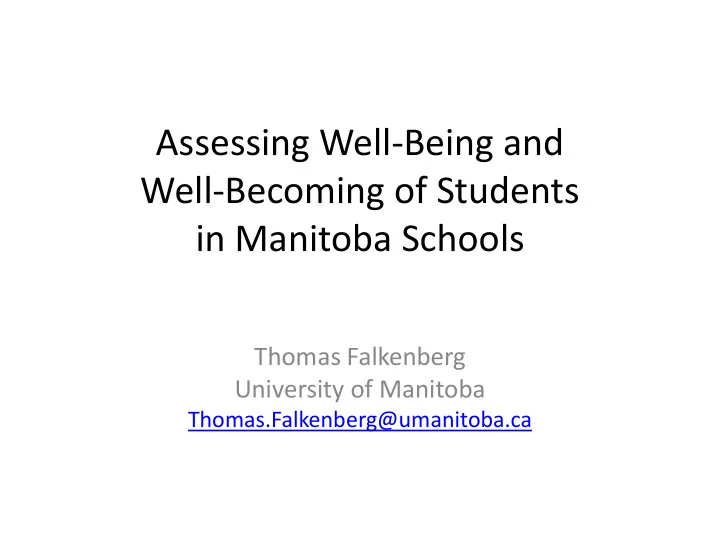

Assessing Well-Being and Well-Becoming of Students in Manitoba Schools Thomas Falkenberg University of Manitoba Thomas.Falkenberg@umanitoba.ca
Overview I. The Core Problem of Assessing/Measuring “Student Success” II. A Research-Based Framework of Indicators of Well-Being and Well-Becoming (for Students)
I. The Core Problem
I. The Core Problem
I. The Core Problem Observations: • on-going shifts in societal values / priorities / perspectives • current dominant perspective: economic competitiveness
I. The Core Problem Examples of Different Discourses 1. OECD: • PISA • “Better Life Index” (incl. “civic engagement”, “work-life balance”) 2. Quality of Life in Canada • GDP / economic growth • Canadian Index of Wellbeing (CIW)
I. The Core Problem Relationship to school education: • societal values impact the public’s view on the purpose of school education (e.g., 21 st century skills; role of school mathematics) • school education’s role to honour the principle of shifting societal values by balancing the views and values of the current generation with the potentially different views and values of future generations (“public education”)
I. The Core Problem
I. The Core Problem Observations: • What is systematically measured and publically reported will give rise to public concern. (What is not systematically measured and not publically reported is less likely to give rise to public concern.) • Public concern impacts the allocation of resources.
I. The Core Problem Implications for Assessing Student Success: • Because we value (in terms of resources) what we measure, we should measure all that we value as student success.
I. The Core Problem Examples of Different Discourses Measuring Success of Public Education in Canada: • PCAP (CMEC) • People for Public Education (Ontario) (“Measuring What Matters”) • Leading Indicators (O’Leary & Young, 2015) (“Schools should prepare students for life” (p. 3).)
I. The Core Problem The Core Problem of Assessing/Measuring “Student Success” = What is the purpose of school education in light of communal values? the purpose reflects but also the purpose defines the purpose defines influences communal values what we value as what we need to student success assess/measure as student success
I. The Core Problem Mission To ensure that all Manitoba’s children and youth have access to an array of educational opportunities such that every learner experiences success through relevant, engaging and high quality education that prepares them for lifelong learning and citizenship in a democratic, socially just and sustainable society. (Manitoba Education and Advanced Learning)
I. The Core Problem The purpose of school education is to help students develop the skills, knowledge and attitudes to be able to live a flourishing life now (well-being) and in the future (well- becoming). • quality of life discourse • to live well requires skills, knowledge, and attitudes
II. A Framework of Indicators Some fundamental ideas • Research-based “systemic eclecticism” (Allport, 1964) • Holistic and systemic approach • Considering well-becoming and well-being • Distinguishing between means and ends • Considering human needs • Embedded in the values of the community
II. A Framework of Indicators inner aspect outer aspect “life- chances” “life- results” (Veenhoven, 2000)
II. A Framework of Indicators inner aspect outer aspect “life- chances” “life- enjoying life results” Hedonistic psychology: enjoyment (e.g., Kaneman, Diener, & Schwarz, 1999)
II. A Framework of Indicators inner aspect outer aspect “life- chances” having positive “life- personal and enjoying life communal results” relationships Social psychology: “interpersonal flourishing” (e.g., Ryff & Singer, 2000)
II. A Framework of Indicators inner aspect outer aspect “life- chances” having positive “life- living a meaningful personal and enjoying life communal results” life relationships Eudaimonic/humanistic/existentialistic psychology: finding meaning in life; self- determination; living an “authentic” life (e.g., Ryan & Deci, 2000)
II. A Framework of Indicators inner aspect outer aspect having opportunities to engage “life- capabilities one’s capabilities chances” having positive “life- living a meaningful personal and enjoying life communal results” life relationships Philosophy/Economics: Capabilities Approach (CA) to assessing a person’s quality of life (e.g., Nussbaum, 2011; Sen, 2009)
II. A Framework of Indicators inner aspect outer aspect capabilities for “life- having opportunities to engage Subsistence Protection Affection chances” one’s capabilities Understanding Participation Idleness Creation Identity Freedom having positive “life- living a meaningful personal and enjoying life communal results” life relationships Psychology/Economics: human needs (e.g., Maslow, 1954; Max-Neef, 1991)
II. A Framework of Indicators “... by their own theories of human nature psychologists have the power of elevating or degrading this same nature. Debasing assumptions debase human beings; generous assumptions exalt them” (Allport, 1964, p. 36).
Biggeri, M., Libanora, R., Mariani, S., & Menchini, L. (2006). Children conceptualizing their capabilities: Results of a survey conducted during the First Children’s World Congress on Child Labour. Journal of Human Development, 7 (1), 59–83. Max-Neef (1991) Biggeri et al. (2006) Life and physical health Subsistence • Shelter and environment • Protection Bodily integrity and safety • Freedom from economic and non-economic exploitation • Affection Love and care • Mental well-being • Social relations • Education Understanding • Participation Participation • Social relations • Idleness Time autonomy • Leisure activities • Creation Leisure activities • Identity Religion and identity • Respect • Freedom Mobility • Religion and identity •
II. A Framework of Indicators inner aspect outer aspect capabilities for “life- having opportunities to engage Subsistence Protection Affection chances” one’s capabilities Understanding Participation Idleness Creation Identity Freedom having positive “life- living a meaningful personal and enjoying life communal results” life relationships
Recommend
More recommend